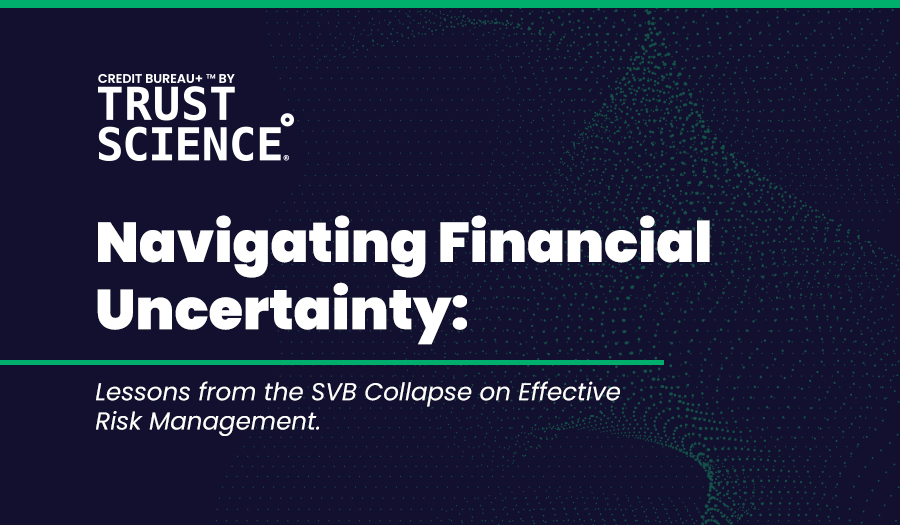In the next three years, digital lending (using AI) is expected to double in size, reaching as high as 10% of the total loans in the US and Europe. The use of artificial intelligence has the potential to alter the status quo in the following ways substantially:
AI Can Avoid Traditional Reporting and Crediting Systems
AI can incorporate new forms of data like payment of rent, utility, telephone bills, consented banking history, loan data, court data, giving a more comprehensive picture of the borrower’s credit. In a similar vein, Trust Science®, a FinTech SaaS delivering Credit Bureau 2.0®/Credit Bureau +™, is using AI to produce highly predictive credit scores by leveraging public data, proprietary data, and consented banking data. Trust Science’s cloud-based SaaS decision support platform processes these complex data sets to promptly deliver a fully compliant and explainable AI- and ML-powered score. Trust Science® is helping deserving people get the loans they deserve, free from the constraints of old data to eliminate much of the traditional subconscious lending biases that may have left lenders vulnerable to costly litigation while bringing substantial returns on investment.
Digital Footprint Analysis
With a customer’s informed consent, AI can collect publicly available digital information like spending behavior, employment histories, and organizations customers belong to. The supplemental information produces a more accurate measure of their creditworthiness. Trust Science ® uses patented algorithms to analyze publicly available digital information and consented consumer data, thereby collecting and analyzing thousands of data points beyond traditional bureaus.
Improving Risk-Adjustment Margins
In the increasingly volatile credit lending environment, lenders (especially short-term lenders) must make smarter underwriting decisions to remain profitable in the subprime, non-prime lending space. Lenders can increase profits and leverage assets more effectively by using AI software to assess the worthy borrowers and charge them an appropriate interest rate, allowing feasible repayments of the loan. The Credit Bureau +™ offered by Trust Science® uses a compliant system that generates scores based on data trifecta: lender’s data, customer’s data, and Trust Science® proprietary data that includes consented structured and unstructured publicly available data. Such data integration generates highly reliable credit scores. It allows lenders to improve loan inclusivity, expand loan originations, and grow business with confidence in their decision-making process.
AI in Loan Origination and Loan Management Systems
Arguably, AI’s greatest asset is its versatility; its ability to be integrated into any system. AI, for example, can be integrated into loan origination systems (LOS) and loan management systems (LMS) as a way to enhance one’s long-term loan evaluation processes, or even improve their data access. These types of AI integrations, or add-ons, can help to significantly reduce processing time, operational costs, and the overall accuracy of customer (borrower) analysis. The latter is where AI’s potential with LOS/LMS systems truly lies.
Machine Learning (ML), a subset of AI, is still a black box concept for many organizations looking to enhance their decision-making through massive amounts of data analysis. Many financial institutions currently rely on LOS/LMS systems to help support their employees by providing additional ‘decision support.’ With the help of AI, or ML, lenders can improve the accuracy and fairness of their credit scoring techniques by creating highly informed evaluation models. Due to the speed and nature of AI, financial institutions can use AI to automate substantial amounts of the loan decision making process while also improving the accuracy, fairness, and consistency of the results. This is where Trust Science®’s value is fully on display.
Through its cutting-edge machine learning platform and exclusive dataset, Trust Science® enhances lender workflow wherever static, or standalone, LOS/LMS exist, by bringing additional “decision support” to the equation. With the ability to integrate into nearly any LOS/LMS platform, Trust Science®’s ML can leverage its growing, alternative data set to create models and scoring routines that avoid using prohibited factors and prioritize precision over anything else. Essentially, Trust Science® uses machine learning to automate the human Loans Officer, and provide detailed, ethical client (borrower) credit evaluations in a short amount of time and without personal biases. For LOS/LMS systems that are used by thousands of employees, this can be an extremely valuable resource for both the customer, employee, and company alike.
Elimination of Errors
The use of AI in LOS/LMS reduces the likelihood of human error in processing loan applications. AI can also create a management system that identifies customer behavior patterns when they are close to bankruptcy, reducing risk for lenders and maintaining a system of worthy borrowers who will continue in the credit lending economy. At Trust Science®, credit scoring machine learning models evolve based on patented methods to eliminate human error and automate decision-making processes. Business decisions are made based on continuously evolving new information rather than static data collected just once.
Furthermore, the outbreak of the global pandemic has led to a macroeconomic crisis in the US where people were unable to work and did not have regular incomes. This has proportionally increased the number who do not have access to affordable credit. Such an environment has made traditional credit scoring even more redundant due to the rising economic uncertainty. AI and machine learning can use proprietary data to predict borrowers’ ability and willingness to pay loans, thus making this technology more efficient and trustworthy during these perilous times. Traditional methods have lacked innovation, and therefore, were not able to adapt to this new economic environment. AI in credit scoring can lead to more inclusive lending models, offering the subprime and credit invisibles an opportunity to enter the credit market economy. Besides that, it will allow financial institutions to speed up their economic recovery by unlocking the potential and demand of the underserved borrowers.
To learn more about Trust Science’s powerful Decision System that empowers lenders to increase originations and decrease defaults, helping borrowers get the money they deserve, contact us today.







Medhat Mounir
Very interested in credit scoring techniques through big data from multiple